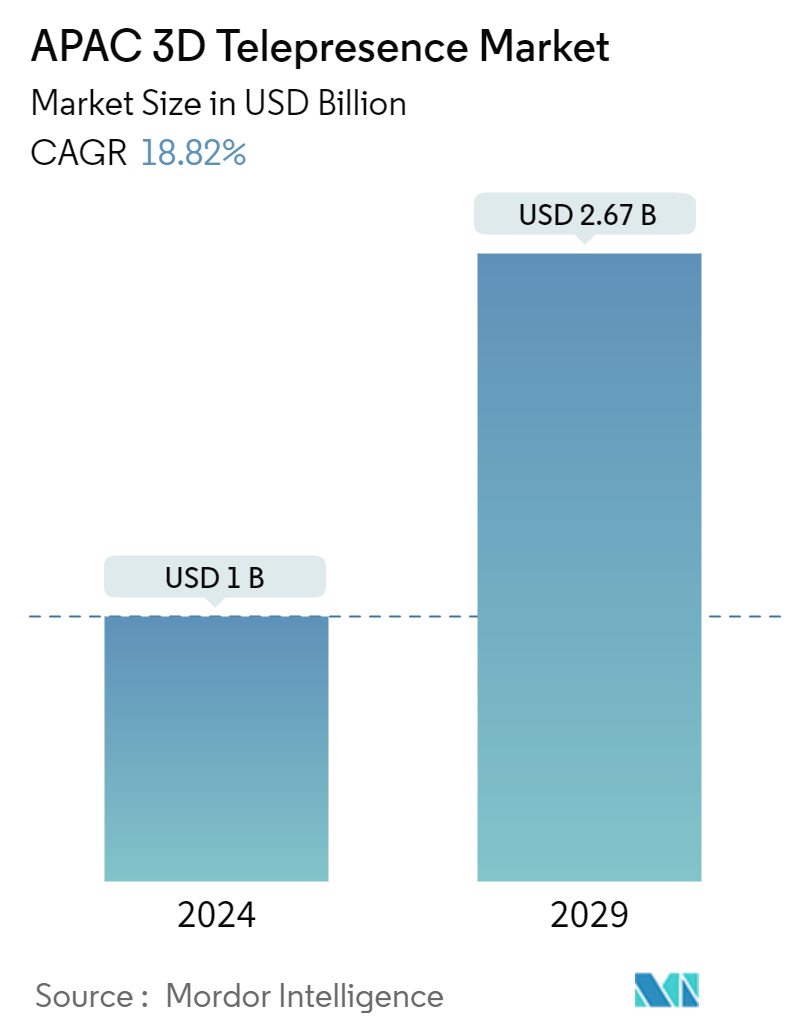Market Size of APAC 3D Telepresence Industry

| Study Period | 2019 - 2029 |
| Base Year For Estimation | 2023 |
| Market Size (2024) | USD 1 Billion |
| Market Size (2029) | USD 2.67 Billion |
| CAGR (2024 - 2029) | 18.82 % |
| Market Concentration | Low |
Major Players
*Disclaimer: Major Players sorted in no particular order |
APAC 3D Telepresence Market Analysis
The APAC 3D Telepresence Market size is estimated at USD 1 billion in 2024, and is expected to reach USD 2.67 billion by 2029, growing at a CAGR of 18.82% during the forecast period (2024-2029).
The Asia Pacific region, known for its rapid technological advancements and large population, has been a significant market for various emerging technologies, including 3D telepresence. The need for enhanced remote communication and collaboration in various sectors has driven the demand for 3D telepresence solutions.
- The level of infrastructure development, including high-speed internet connectivity and advanced communication networks, plays a crucial role in enabling the adoption of 3D telepresence solutions. Countries with robust telecommunications networks are likely to see higher adoption rates.
- 3D telepresence offers a more immersive and lifelike experience than traditional video conferencing. The Asia Pacific region is known for its booming entertainment and gaming industries. Enhanced user experience in 3D telepresence could lead to innovative applications in these fields, such as virtual concerts, live events, and multiplayer gaming experiences.
- The increasing demand for time-saving technologies is a significant driver for the growth of the Asia Pacific 3D telepresence market. 3D telepresence offers a more immersive and engaging communication experience than traditional methods. In addition to time savings, organizations can also realize cost savings by reducing travel expenses and associated costs related to physical meetings and events.
- High costs and limited commercialization are significant factors that can restrain the growth of the Asia Pacific 3D telepresence market. Developing, implementing, and maintaining 3D telepresence solutions can involve substantial costs. This includes investments in specialized hardware such as 3D displays, high-definition cameras, advanced audio equipment, and network infrastructure capable of handling the data requirements.
APAC 3D Telepresence Industry Segmentation
3D TelePresence achieves true depth without the usage of 3D glasses. A person from another part of the world can appear life-size within the room for live two-way communication while making eye contact. The Scope of the market includes solution-type hardware and software, applications including education, advertising, conferencing, and customer service, among others.
The Asia Pacific 3D telepresence market is segmented by solution type (software and hardware), by application (education, advertising, and conferencing), and by geography (China, Japan, India, South Korea, and the Rest of Asia Pacific). The market sizes and forecasts are provided in terms of value in USD for all the above segments.
| By Solution Type | |
| Software | |
| Hardware |
| By Application | |
| Education | |
| Advertising | |
| Conferencing |
| By Country | |
| China | |
| Japan | |
| India | |
| South Korea | |
| Australia and New Zealand |
APAC 3D Telepresence Market Size Summary
The Asia Pacific 3D telepresence market is poised for significant growth, driven by the region's rapid technological advancements and the increasing need for enhanced remote communication solutions. This market is characterized by its ability to offer more immersive and engaging experiences compared to traditional video conferencing methods, making it particularly appealing in sectors such as entertainment and gaming. The demand for time-saving and cost-effective technologies is a major factor propelling market expansion, as organizations seek to reduce travel expenses and improve collaboration across geographic locations. However, the high costs associated with developing and maintaining 3D telepresence systems, including specialized hardware and advanced network infrastructure, pose challenges to widespread adoption.
China plays a pivotal role in the Asia Pacific 3D telepresence market due to its manufacturing capabilities and strong focus on technological innovation. The country's robust telecommunications infrastructure and government support for technological advancements, such as the "Made in China 2025" initiative, are expected to drive the development and adoption of 3D telepresence solutions. The market is highly fragmented, with major players like TelePresence Tech, Cisco Systems Inc., and Microsoft Corporation actively engaging in partnerships and acquisitions to enhance their offerings. Events such as the Mobile World Congress and Pro Integration Future Asia 2023 highlight the ongoing interest and investment in 3D telepresence technologies, underscoring their potential to transform communication and collaboration in the region.
APAC 3D Telepresence Market Size - Table of Contents
-
1. MARKET DYNAMICS
-
1.1 Market Drivers
-
1.1.1 Enhanced User Experience
-
1.1.2 Increasing Demand For Time-Saving Technologies In Organizations
-
-
1.2 Market Restraints
-
1.2.1 High Costs And Limited Commercialization
-
-
-
2. MARKET SEGMENTATION
-
2.1 By Solution Type
-
2.1.1 Software
-
2.1.2 Hardware
-
-
2.2 By Application
-
2.2.1 Education
-
2.2.2 Advertising
-
2.2.3 Conferencing
-
-
2.3 By Country
-
2.3.1 China
-
2.3.2 Japan
-
2.3.3 India
-
2.3.4 South Korea
-
2.3.5 Australia and New Zealand
-
-
APAC 3D Telepresence Market Size FAQs
How big is the APAC 3D Telepresence Market?
The APAC 3D Telepresence Market size is expected to reach USD 1 billion in 2024 and grow at a CAGR of 18.82% to reach USD 2.67 billion by 2029.
What is the current APAC 3D Telepresence Market size?
In 2024, the APAC 3D Telepresence Market size is expected to reach USD 1 billion.

